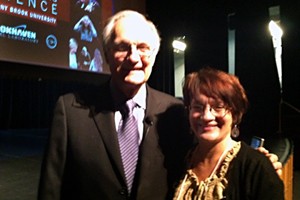
Journalism Professor Meets MASH Star, Learns to Communicate Science
Elissa Yancey, educator associate professor in the
in the McMicken College of Arts and Sciences at the University of Cincinnati, joined 35 university leaders from around the country, and actor Alan Alda, at the Communicating Science Summer Institute.
The conference, dedicated to improving the way scientists communicate with the public, was conducted by the Center for Communicating Science at Stony Brook University in New York. The meeting took place June 5-9 and was funded by the Kavli Foundation and the U.S. Department of Education.
Universities from all over the world, from Yale to Sydney, Australia, are struggling with finding effective ways to train scientists and all manner of researchers to talk about their work clearly, concisely and with passion, Yancey says. I view science literacy as so critical, both personally and politically. Journalists and scientists need to do a better job of making sure that facts are understood and communicated in ways that are both interesting and memorable. Not only can we do that, I believe we must if we want to be good stewards of the world around us.
Alan Alda, a visiting professor at Stony Brook and a lifelong science lover, gave the conferences keynote address, in which he recalled his years as host of the documentary series Scientific American Frontiers, interviewing more than 700 scientists around the world. Many of them, he said, were brilliant researchers doing fascinating work but were unable to tell their stories in a compelling way. Too often, he said, they reverted to lecture mode, rather than talking in a person-to-person, conversational way that engages the listener. Aldas desire to help scientists do better sparked the creation of the interdisciplinary Center for Communicating Science in 2009.
Attendees participated in training methods like improvisational theater exercises to help scientists connect more directly with their audiences. The goal was to help scientists learn how to pay close attention to the needs and reactions of the people they are communicating with so they can adjust their message to be more effective.
Yancey hopes to implement some of the institutes ideas at UC.
I've been working across disciplines to help train researchers on East and West Campuses how to communicate effectively with a wide range of audiences, she says. I'm looking forward to continuing and expanding that work by exposing young researchers to journalism students, by offering more workshops in conjunction with the Department of Epidemiology and Biostatistics, and by putting out the call to others who want to join me on this exciting journey.
Related Stories
UC students recognized for achievement in undergraduate research
April 29, 2024
The University of Cincinnati recognizes undergraduate student researchers for outstanding achievement in the sciences and humanities.
UC students recognized for achievement in real-world learning
April 29, 2024
University of Cincinnati students take different paths to gain resume-building work experience.
Ancient Maya blessed their ballcourts
April 26, 2024
Using environmental DNA analysis, researchers identified a collection of plants used in ceremonial rituals in the ancient Maya city of Yaxnohcah. The plants, known for their religious associations and medicinal properties, were discovered beneath a plaza floor upon which a ballcourt was built, suggesting the building might have been blessed or consecrated during construction.
